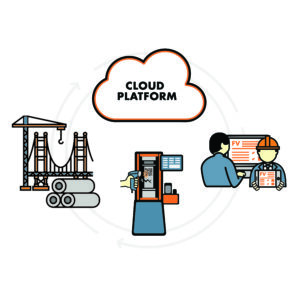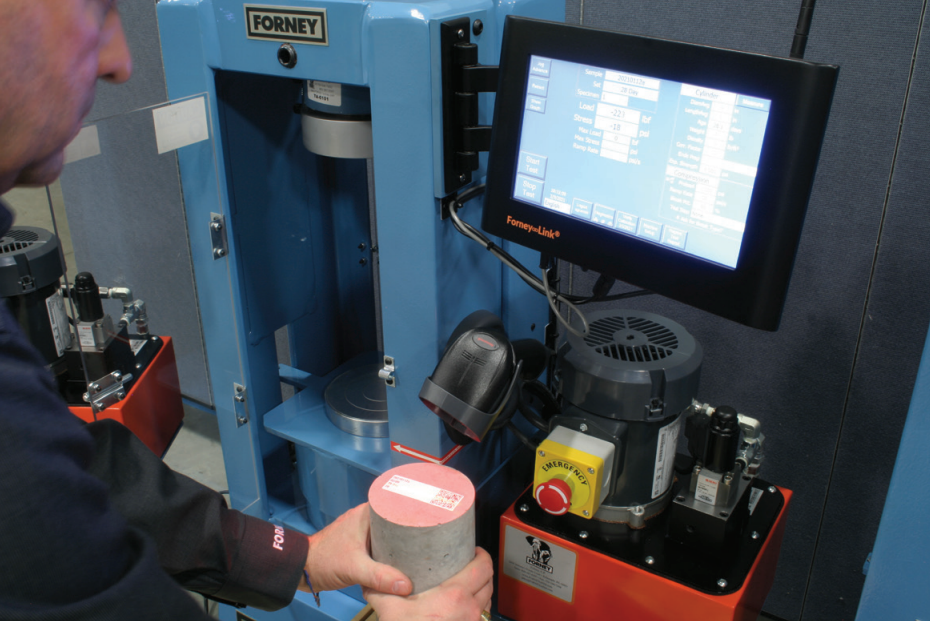Not all CMT software is created equal. Only the best CMT software can adapt to your lab’s unique needs and enhance accuracy, productivity and transparency. In this blog, we answer five common questions:
- What is CMT software and why is it important?
- What are the best CMT software features?
- What are the benefits of using modern CMT software?
- How has it modernized through the years?
- How can it adapt to testing needs?
Let’s dig in.
What Is CMT Software & Why Is It So Important?

Construction materials testing (CMT) software automates how data moves through the testing workflow, from the field to the lab to the office and beyond.
CMT software includes:
- A private cloud database.
- An interface for accessing and communicating with that database.
- A two-way integration with testing machines and other software.
These building blocks create a fully automatic testing workflow to reduce error-prone human intervention and generate consistent, accurate and traceable results. We’ll cover more on how this works in the next section. First, why does it matter?
This type of solution is used by material producers and testing organizations to improve productivity, accuracy and transparency of testing results. With this solution, testing organizations can not only get more tests done in less time but also defend test methods and results.
This also matters to project owners – whether public or private. Project owners, government agencies and DOTs need to trust that construction materials meet the standards a project requires to keep projects on track. CMT software helps them do just that.
CMT software is not only crucial to testers, material producers and other construction project stakeholders but also to the rest of society – those who live in apartment buildings and drive on roads and over bridges. Accurate and verifiable results about the quality (namely, the confirmed strength) of construction materials is the difference between safe infrastructure and dire consequences.
Testing construction materials is critical, which means the solution you use to get the job done and manage it all is just as important. How can you be sure about your results? It starts with these essential CMT software features.
4 Key Features of Construction Materials Testing Software
In order to enhance the construction materials testing process, the best CMT software should (at least) include these four key features.
#1. loT Integration
This feature is what makes a truly automatic CMT workflow possible. Having an unbreakable, auditable link between the specimen, the test machine and the results are critical.
This integration allows data to flow to and from the machine in a structured, unalterable and secure format, eliminating all human intervention from the material testing workflow. Before the test, it’s nearly impossible to identify specimens incorrectly or test on the wrong date because the machine “knows” what it’s testing. After the test, results automatically flow from the machine to the aforementioned private cloud database.
#2. Flexible CMT Reporting
Material producers and testers need to securely access, analyze and report on their testing results – and project stakeholders need to be able to trust that those results are 100% accurate.
As mentioned, the best CMT software requires an interface for accessing and communicating with the data stored in the private cloud database. When it comes to results reporting specifically, users should have two options:
- Results reporting native to the CMT software
- Results reporting through their existing LIMS or other system
The best CMT software allows users to access, analyze and report on results without risk of bias or human error but with their technology of choice. Powered by IoT integration, users can keep data consistent and verifiable by never needing to manually re-enter it into other systems.
Also, professional engineers need to efficiently manage reports from approval to stakeholder distribution. CMT software should offer a streamlined and transparent digital report approval process so the project can efficiently move forward.
#3. Automatic Alerts and Notifications
CMT software doesn’t just automate the entire testing workflow. It also automates proactive alerts and notifications.
This helps testing organizations stay on top of any possible testing issues – like overdue cylinders and low strengths – before they create significant risk. The ability to be proactive with potential problems will enhance the testing workflow and provide the best results and timelines to projects as a whole.
#4. Mobile Field Application
The CMT workflow starts in the field where wet concrete tests are conducted and samples are created. This means CMT software also needs to start in the field.
A CMT software-powered mobile app allows field technicians to capture sample data, create new specimens, claim specimens to deliver to the lab and locate specimens on a map. Lab and project managers and principal engineers can also validate field work with lab testing and streamline complex workflows for greater productivity and profitability across the entire CMT workflow.
These features are only a glance into what’s possible with modern construction materials testing software – and they suggest a number of benefits for all stakeholders.
What Are the Benefits of Using Modern CMT Software?
- Testing Organizations: CMT software not only prevents redundant data entry but also allows operators to run more tests in less time. As a result, lab engineers and technicians can focus on more value-add tasks, and testing labs can defend results and methods with unalterable, original test data.
- Producers: From concrete and ready-mix to precast and cement, material producers are able to improve product performance, quality and consistency throughout the QC lifestyle. With faster tests with higher levels of accuracy, modern CMT software allows producers to optimize mix design and deliver product on-time and on-spec.
- Project owners: CMT software helps project owners in both the private and public sectors track and review the lineage of construction materials testing data for all labs and construction projects. By allowing them to access accurate, unalterable test results, project owners, government agencies and DOTs can better trust the materials, keep projects moving and enhance public safety.
The benefits of modern CMT software are clear. To really understand why this is so transformational for the construction materials testing industry, let’s examine the history of CMT software.
How Has Materials Testing Software Changed Over The Years?
Manual Testing
In the past, testing was conducted manually – specimens were labeled with markers, and load settings were adjusted by hand. This was a very tedious, time-consuming process that was extremely susceptible to human error.
Semi-Manual Testing
This naturally pushed the industry towards semi-automated testing. In general, semi-automated testing involves an automatic testing machine and LIMS or custom software. Despite positive steps in the right direction, there are still steps in the workflow that require human intervention. For example, technicians have to transfer and enter data manually from the machine to their LIMS or database. Also, they have to manually label specimens and make sure to bring the right specimen to the right machine on the right day. The machine, while automatic and thus efficient to run tests, does not “know” what it’s testing, and the setup and control are entirely dependent on the technicians.
Truly Automated Testing
Semi-automated testing is not truly automated testing. The past few years, innovations in modern CMT software features have paved the way for truly automated testing. In short, human hands no longer need to intervene at any point in the middle of the process, preventing the potential for information gaps and errors.
Although technicians still have to physically bring the correct specimen to the machine on test day, truly automated testing provides a benefit that’s not possible in a semi-automated or manual configuration: if any parameters are abnormal, the machine will flag the test and ask if everything is correct before proceeding. If any parameters are impossible, the machine will not enable the “start test” button. If you attempt to run a test on the wrong day, the machine will warn you and require confirmation to continue.

Otherwise, you can start the test at the push of a button. After the test is completed, the machine transfers the results to the private cloud database and then to the LIMS of choice.
How Can CMT Software Adapt to Your Testing Needs?
Technology changes rapidly. For the construction materials testing industry to keep up, CMT software needs to be adaptable. This is especially important as the construction industry is only just now catching up with the rest of the digital world.
The key to adaptable CMT software? Feature #1 – IoT integration. An open system will allow you to adapt as other dynamics in your organization change. These integrations allow test results to sync and move freely between multiple systems, such as the cloud database, machines, LIMS, accounting systems and more.
For example, if you decide to move to a different LIMS in the future, you won’t have to deconstruct your entire workflow to make that possible. Integrated CMT software sits at the center of your process, enables an easy pivot for your organization and gives your firm the tools it needs to remain successful – now and in the future.
The adaptable nature of CMT software also depends on the support it comes with. After all, technology is only as useful as it is usable. So, look for a solution that has a short learning curve and quick technical support. When CMT workflows must evolve, you’ll want to work with an experienced, dedicated team that knows the unique issues of construction materials testing. These convenient qualities are what make CMT software so adaptable and flexible with your testing needs.
Conclusion
Modern CMT software features have made materials testing a lot easier and worlds more transparent than past solutions. No matter what your role is in the construction process, you will certainly experience the benefits of using modern and adaptable materials testing software.
Want to future-proof your CMT workflow with a cloud-based platform? ForneyVault can help. Book a demo with us today to see how it works.